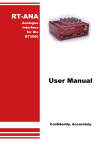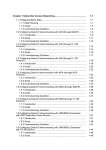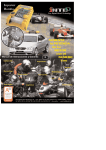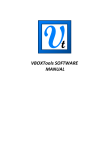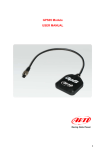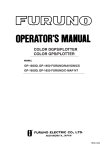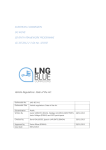Download RT3000 Inertial and GPS Navigation System
Transcript
RT3000 Training RT3000 Inertial and GPS Navigation System Notes 1 Oxford Technical Solutions RT3000 Training Contents • • • • • Overview of RT3000, Outputs, Internal Components, Functionality Software Installation and PC Setup RT3000 Configuration Software Using the RT3000 RD files 2 Notes Oxford Technical Solutions RT3000 Training What is in the RT3000 box? Notes In the picture on the left, the Inertial Measurement Unit is on the left. The Pentium processor is at the bottom on the right. The top board contains the connections to the IMU, Front Panel Power Supply, Pentium Processor and two cables to the GPS cards. The GPS cards (not shown) hang down from the lid. The RT3000 has been constructed to operate in high-vibration, high-shock environments. Connectors are suitable for highvibration. Glue is used to ensure connections do not fall apart. PCBs are mounted very rigidly for long term reliably, for removing resonance and to prevent them from “chattering”. 3 Oxford Technical Solutions RT3000 Training What does the RT3000 Measure? • • • • • • • Position Velocity Acceleration Orientation Angular Rates Angular Accelerations Slip Angle 4 Notes These are the core measurements made by the RT3000. Oxford Technical Solutions RT3000 Training Position Measurements Notes The position measured by the RT3000 is in the WGS-84 co-ordinate system. The outputs are Latitude, Longitude and Altitude in this co-ordinate system. Conversion to other co-ordinate systems may be required (e.g. OSGB36 in the UK). The RT3000 can also output positions in metres on a local grid. Because the earth is curved it is not possible to have a measurement in metres that covers the whole earth surface. To use the local grid the Latitude and Longitude of the origin or X=0, Y=0 needs to be entered in to the RT3000 configuration software. Then the X,Y position measurements are output on the CAN bus. The RT3000 also integrates the horizontal velocity to give a distance measurement. This measurement always increases. 5 Oxford Technical Solutions RT3000 Training Velocity Measurements Notes Velocity can be measured as North/East, like GPS, or Forward/Lateral like Optical Speed Sensors. The RT3000 measures True Heading, so it is possible to separate the Forward Velocity from the Lateral Velocity. In the example here an aircraft is flying straight in a cross-wind. The Track or Course over Ground that the aircraft takes is not the same as Heading because of the cross-wind. This is the same effect as the Slip Angle in cars. The Heading of the car is not the same as the angle of the Velocity Vector (Track Angle). The underlying calculations in the RT3000 integrate the accelerations to give North, East and Down velocities. Velocity Measurements North Velocity East Velocity Down Velocity 6 Forward Velocity Lateral Velocity Horizontal Speed 3D Speed Oxford Technical Solutions RT3000 Training Acceleration Measurements Notes The RT3000 accelerometers measure in the XYZ directions of the vehicle. When the vehicle has some Roll (or Pitch) Angle then the Y-Acceleration (and XAcceleration) have some component of gravity in them. The RT3000 knows the Roll and Pitch Angles very accurately, so it can rotate the XYZ-Accelerations to give Forward, Lateral and Down Accelerations. The Forward and Lateral Accelerations do not have any component of gravity in them. The Lateral Acceleration is the rollcorrected Acceleration. The Lateral Slip Rate is an acceleration that measures how you are deviating from a perfect circle. Acceleration Measurements X-Acceleration Forward Acceleration Y-Acceleration Lateral Acceleration Z-Acceleration Down Acceleration 7 Lateral Slip Rate = LatAcc - ωd * Vf Oxford Technical Solutions RT3000 Training Orientation Measurements Notes The RT3000 measures the Heading (the angle to True North), the Pitch and the Roll angles of the car. 8 Oxford Technical Solutions RT3000 Training Angular Rate and Angular Acceleration Measurements Notes The Angular Rates and Angular Accelerations of the vehicle can be measured about the Body Axes (XYZ axes of the car) or the Level Axes (Forward, Lateral and Down). Note that the directions on the drawing are not necessarily correct. The Euler Rates are as follows: • Roll Rate = X-Rate • Pitch Rate = Lateral Rate • Yaw Rate = Down Rate The Angular Accelerations are in the same directions as the Angular Rates 9 Oxford Technical Solutions RT3000 Training RT3000 Co-ordinate System Notes The conventions used by the RT3000 are those adopted by most navigation systems. Engineers who work with vehicles tend to have the Z-axis pointing up, rather than down and, therefore, the Y-axis points left rather than right. Care must be taken to ensure that the correct signs are applied to the RT3000 outputs if your co-ordinate system is different. 10 Axis Direction Vehicle Axis X North Forward Y East Right Z Down Down Oxford Technical Solutions RT3000 Training RT3000 Outputs Notes The RT3000 has several output formats. RS232. This normally transmits a binary protocol that we call NCOM. This is specific to the RT3000. We provide C code drivers to help you if you want to decode this yourself. If your system is designed to go to a Steering Robot then the RS232 may be configured for a different output format. Ethernet. The NCOM data is also transmitted using a UDB broadcast over Ethernet. CAN. The CAN output is suitable for connecting to may data acquisition systems. Several CAN DBC files are provided to make it easier to connect the RT3000. Analogue. The RT-ANA module can convert CAN messages to analogue voltages. The RT3000 outputs four special CAN messages for the RT-ANA. The RT-ANA just converts the data in these messages to analogue voltages. The RT3000 is responsible for configuring the channels on the RT-ANA. 11 Oxford Technical Solutions RT3000 Training RT3000 PC Software Installation Insert the CD; double-click on the program: rt3ksetup.exe and follow the instructions given by the installer. 12 Notes The CD includes an installer for the RT3000 software. To install the software double-click the rt3ksetup.exe icon on the CD. The installer will install several executables, manuals and CAN DBC files. Enginuity is used to view the output of the RT3000 and capture the outputs to files. RT3000 Config is used to configure the RT3000. This requires the Ethernet on the computer to be set up correctly. RT3000 Post-Process is used to process the data stored in the internal memory of the RT3000. Oxford Technical Solutions RT3000 Training PC Ethernet Configuration – Step 1 Notes The RJ45 Ethernet connector on the RT3000 can be plugged in to a network hub. To connect it directly to a laptop a crossover must be used. The RT3000 is supplied with a suitable crossover coupler and a straight-through RJ45 patch cable. CHECK: If the cable is working correctly then the light on the hub or PC will light up when connected to the RT3000, as shown above. PC Ethernet Configuration – Step 2 Notes Your PC may already have a TCP/IP network configuration. This may need to be changed before you can connect to the RT3000; changing your network configuration may prevent your computer from working on your current network. From Windows menu select the Control Panel. 13 Oxford Technical Solutions RT3000 Training PC Ethernet Configuration – Step 3 Next, select the Network Settings. 14 Select the Local Area Connection from the Network Connections Window. Notes If you have more than one Ethernet adapter installed in your PC then you can set up one for the RT3000 and one for your normal network Oxford Technical Solutions RT3000 Training PC Ethernet Configuration – Step 4 The Local Area Network Properties Dialog Box will be shown. Click on the Properties button to change the properties of your network. 15 Notes The connection to the RT3000 only requires the Internet Protocol to be installed. It is not necessary to remove the other items. There will be several items in the connection properties. If the Internet Protocol is not installed then it must be installed now, using the Install... button. Once installed use the Properties button to configure the network. Oxford Technical Solutions RT3000 Training PC Ethernet Configuration – Step 5 Now the settings can be configured. The IP address used should be 195.0.0.n where n is not the same as the RT3000. The settings shown to the left should work correctly. Once set, press OK. Press OK again in the Local Area Connection Properties window. 16 Notes In Windows XP it is not normally necessary to reboot the computer. However, if you are logged on to a server that requires the IP address to be fixed then Windows XP will not change the IP address until after rebooting. Oxford Technical Solutions RT3000 Training PC Ethernet Configuration – Step 6 From Windows menu choose Run... Then in the box that appears type “cmd”. In Windows 95/98/Me type “command” instead. In the Command Window type: ipconfig Notes The IP settings can also be accessed in the System tray. Click on the Network Settings icon, if present, and go to the support page of the Local Area Connection Status Page. This program displays the Internet Protocol Settings. The IP Address and the Subnet Mask should be as shown below. The Default Gateway can be blank. 17 Oxford Technical Solutions RT3000 Training Viewing Files on the RT3000 After the network is configured correctly, Internet Explorer can be used to connect to the RT3000. Open Internet Explorer. In the address box type: ftp://195.0.0.m where m is the address of the RT3000. 18 Notes The files with an “.rd” extension are the raw data files that the RT3000 logs. These contain all the information from the Inertial Sensors and from the GPS cards. The RT3000 Post-Process program can turn these in to NCOM outputs (binary) and text outputs. The “mobile.*” files are the configuration files for the RT3000. You should not change these. The RT3000 Config program should be used to modify these files. From Internet Explorer drag-and-drop can be used to get the files off the RT3000. The RT3000 does not delete any files itself. When the disk gets full it is necessary for the user to delete the files themselves. If the disk is full then the RT3000 stops logging. To delete a file select it and delete it in the normal way (using the delete key or using the menu). Oxford Technical Solutions RT3000 Training RT3000 Configuration Notes Default Settings. To use the default settings select this radio button. The following pages will contain the default settings that the RT3000 was delivered with. Read from a Folder. It is possible to store a configuration in a folder. The configuration requires several files so it is tidier to keep it in a folder by itself. To read the configuration from a folder select this radio button. A group box will appear and the folder can be selected. Read from an RD File. The RD file stored in the RT3000 contain the configuration used when the RT3000 was running. To load the configuration from an RD file use this option. Read Initial Settings from RT3000. If the RT3000 is connected to the computer via Ethernet then it is possible to read the initial settings directly from the RT3000. The initial settings are the settings that the RT3000 starts up with, before it makes any improvements. Select this radio button and enter the correct IP address of your RT3000. 19 Oxford Technical Solutions RT3000 Training RT3000 Configuration – Orientation Notes The RT3000 can be mounted at any angle in the vehicle. The outputs can be rotated so that the measurements can be referenced to the vehicle co-ordinate frame. For correct initialisation it is also necessary to get the heading orientation correct. If the ‘vehicle level’ option is used then the pitch and roll orientations must also be correct. The RT3000 gets its initial heading by assuming that the lateral velocity or slip angle is small. If the definition of the vehicle’s X-axis (forward direction) is incorrect in the RT3000 then it will not initialise correctly when the vehicle drives forwards. The orientation of the RT3000 in the vehicle is normally specified using three consecutive rotations that rotate the RT3000 to the vehicle’s co-ordinate frame. To make it simpler to configure the RT3000’s orientation in the vehicle RT3000Cfg asks the user to define the direction that the main connector points in the vehicle. After that stand facing the main connector and enter the direction that the antenna connectors are compared to the main connector. In the list there is no option for the main connector facing upwards or downwards. It is necessary to use the advanced settings to configure the unit to be mounted this way. To make small adjustments use the advanced settings. This allows the user to ‘zero’ any slip angle offsets, pitch offsets or roll offsets. 20 Oxford Technical Solutions RT3000 Training RT3000 Configuration – Primary Antenna Position Notes It is necessary to tell the RT3000 the distance from the measurement point (shown on diagram 14A0007x at the end of the User Manual) to the GPS antenna measurement point. This should be entered in the vehicle’s co-ordinate frame. The accuracy of the measurements should also be specified. Care should be taken here because it is very easy to measure distance to 1cm or better in a straight line. It is much harder to measure to 1cm through a car roof and it is much harder to measure to 1cm if the RT3000 is slightly misaligned in the vehicle. Any alignment errors should be included in the accuracy that you believe you can measure to. Telling the RT3000 that you have measured the distances to 1mm may lead the RT3000 to believe its results are better than they really are. You may be impressed by the accuracy that the RT3000 reports but, in reality, it will not be that accurate. 21 Oxford Technical Solutions RT3000 Training RT3000 Configuration – Secondary Antenna Orientation Notes If your system has two antennas then it is necessary to tell the RT3000 the orientation of the two-antenna system compared to the vehicle. It is critical to tell the RT3000 the exact distance between the two antennas (to 5mm or better). It is best to mount the two antennas on the top of the vehicle. Although it is possible to mount one on the roof and one of the bonnet (hood), in reality the multi-path reflections from the windscreen will degrade the performance of the system. If the antennas are mounted at significantly different heights or if the mounting angle is not directly along a car axis (forward or right) then use the advanced settings. Getting the angle wrong by more than 3 degrees can lead the RT3000 to lock on to the wrong heading solution. The performance will degrade or be erratic if this happens. The RT3000 does not estimate the distance between the two antennas. It is essential to get this right yourself, otherwise the system will not work correctly and the performance will be erratic. 22 Oxford Technical Solutions RT3000 Training RT3000 Configuration – Options Notes Vehicle Starts. If you know that the vehicle will be level when starting (to within about 5 degrees) then the Level option can be used. This saves about 40 seconds during the initialisation process since the RT3000 does not have to take the time to compute an initial roll and an initial pitch. In high vibration environments the Not Level option may not work and so the RT3000 can only start if the vehicle is level and the Level option has been specified. Vibration. The Normal vibration level is adequate for most circumstances. The RT3000 is very tolerant of vibration and has been used successfully in environments with more than 2g RMS using the Normal setting. If the velocity innovations are very high and many GPS packets are being dropped then this setting can be changed. GPS Environment. If the system is used predominantly in open-sky then the open-sky setting should be used. In environments with a lot of GPS multi-path the other two settings can be used. This will allow less accurate GPS measurements to update the system. Differential. The RT3000 can be configured to use several different Differential correction message types on connector J3. The RT-Base transmits RTCA messages. RTCM (RTCM104) or CMR (Trimble) can also be selected or the port can be disabled. The Advanced option should not be used except in specialised applications. 23 Oxford Technical Solutions RT3000 Training RT3000 Configuration – Options Notes WAAS. For WAAS enabled systems the GPS receiver can be set up to receive corrections in North America or Europe. Because WAAS (North America) and EGNOS (Europe) are in test mode they can sometimes be unreliable; the corrections can be disabled by selecting None. For systems that do not have WAAS capability this setting has no effect and is ignored. OmniStar. For OmniStar Enabled Systems the correct satellite should be selected for the region where you are operating. The correct satellite must be selected before OmniStar can send a new license. For systems that do not have OmniStar capability this setting has no effect and is ignored. 24 Oxford Technical Solutions RT3000 Training RT3000 Configuration – Advanced Slip Notes The Advanced Slip feature uses characteristics of land vehicle motion to improve heading and slip angle. This feature must be disabled for airborne and marine systems where the lateral velocity can be significant. The Advanced Slip feature applies heading correction when the land vehicle is not slipping; when the car is slipping the lateral acceleration is usually large enough so that the normal heading corrections provide excellent results. For the Advanced Slip feature to work correctly the system needs to know the position of the rear-wheels on a vehicle with front-wheel steering. (Vehicles with rear-wheel steering should use the front wheels; vehicles with all wheels steering cannot use this feature reliably). Minor steering of the rear-wheels does not significantly affect the results. A position at road height, mid-way between the rear wheels should be used. The Advanced Slip feature also requires some knowledge of the road surface. Three pre-defined options are given, Normal, Low Friction (Ice) and High Friction. The Other feature should not be used. 25 Oxford Technical Solutions RT3000 Training RT3000 Advanced Slip Example Notes In this example a Step-Steer test is shown. The data has been processed both without (top) and with (bottom) Advanced Slip. It can be seen that the slip angle at the end of the test is the same in each case. The slip angle is different at the start of the test. The top graph, without Advanced Slip has about 0.4° of heading drift at the start of the test. During the straight run to the test the heading has drifted. At the end of the test, the acceleration of the test has enabled the Kalman filter to correct the heading drift. The bottom graph, without Advanced Slip has a much smaller heading difference between the start and the end of the test (about 0.1°). Here the Advanced Slip is operating correctly during the straight lead-in to the test and the heading is kept accurate. During the test the Advanced Slip turns off automatically to prevent real Slip Angles from upsetting the Heading. 26 Oxford Technical Solutions RT3000 Training RT3000 Configuration – Options Notes CAN. The CAN bus can be disabled or the correct baud rate can be selected. In systems without the CAN option this should be set to Disabled. Heading Lock. The heading of Single Antenna systems can drift when the RT3000 remains stationary for long periods of time. To solve this the RT3000 includes an option to lock the heading to a fixed value when stationary. This option cannot be used if the vehicle can turn on the spot (i.e. turn with zero speed). With Heading Lock enabled the RT3000 can remain stationary for indefinite periods of time without any problems. For vehicle testing this option is recommended. Garage Mode. The Garage Mode option can be used to stabilise the RT3000 outputs when GPS is not available. For example, GPS can be blocked when the vehicle returns to the garage to have some modifications. Without Garage Mode the RT3000 may drift too far and may not be able to recover. When Garage Mode is active, the RT3000 applies a gentle velocity update and assumes that the vehicle is stationary. This keeps the roll, pitch and velocity within acceptable limits while the RT3000 has no GPS. With Heading Lock also enabled, the RT3000 can also keep the heading accurate while stationary. 27 Oxford Technical Solutions RT3000 Training RT3000 Configuration – Options Notes Initialisation Speed. The default starting speed for the RT3000 is 5m/s. However, some slow vehicles cannot achieve this speed. For these vehicles adjust the Initialisation Speed to a different value. If a speed less than 5m/s is selected then care should be taken to make sure that the RT3000 is travelling straight when it initialises. Displace Output. The RT3000 can displace or move its outputs to another location in the vehicle. This simulates the RT3000 being mounted at the new location, rather than at its actual location. To enable Output Displacement select this option and enter the offsets to the new location in the vehicle. 28 Oxford Technical Solutions RT3000 Training RT3000 Configuration – Options Notes Analogue Outputs. The channels for the RT-ANA are configured in the RT3000. Up to 16 channels can be selected from about 40 different output options. Use this setting to choose the analogue outputs. Angular Acceleration Filter. The RT3000 measures Angular Acceleration. When driving in vehicles, the vibration causes the Angular Acceleration to be very noisy. The RT3000 can filter the Angular Acceleration to reduce the high frequency noise. Several filters can be specified as well as the cut-off frequency. Only the Angular Acceleration outputs are filtered, none of the others. Wheel Speed. The Wheel Speed input is used in survey applications to reduce the drift when GPS is not available. Local Co-ordinates. The Local Co-ordinates option allows the user to configure the Base Latitude and Base Longitude. These are the positions on the test track where the X-Position and Y-Position are zero. A rotation for the Local Co-ordinates can also be specified. 29 Oxford Technical Solutions RT3000 Training RT3000 Configuration – Committing Notes The changes to the RT3000 settings must be performed using Ethernet. It is necessary to configure your computer’s Ethernet settings so it is on the same network as the RT3000. If necessary, ask you system administrator to help. Enter the IP address of the RT3000 that you want to configure. The IP address is usually 195.0.0.x where x is the serial number of the RT3000. The changes to the configuration do not take effect until after the RT3000 is reset (or next power on). To reset the RT3000 after downloading check the Reset RT3000 after downloading files check box. Press Commit to save the configuration on the RT3000. 30 Oxford Technical Solutions RT3000 Training RT3000 Configuration – Keeping a Local Copy Notes Before finishing it is possible to save a copy of the settings in a folder on your computer. This can then be reloaded next time. The Finish screen also lets you know if the settings have been committed successfully to the RT3000 or not. To save a copy of the settings in a local folder check the Preserve these settings in folder check box and enter the folder name. 31 Oxford Technical Solutions RT3000 Training CAN DBC Files • • • • • 32 rt3k_kmh_m.dbc rt3k_kmh_ft.dbc rt3k_mph_m.dbc rt3k_mph_ft.dbc rt3kfull.dbc Notes Five CAN DBC files are provided. These allow for different speed and distance units. The first four files have only got a few Status messages in them. These are the normal Status messages that are used. The rt3kfull.dbc file includes all of the Status messages. Oxford Technical Solutions RT3000 Training RT3000 Block Diagram Notes Here we see the components in the RT3000 in block diagram form. The Accelerometers and Angular Rate sensors are processed by a high speed Digital Signal Processor (DSP) to remove errors caused by vibration. Either one or two GPS cards can be fitted to an RT3000. The RT3000 includes survey-grade GPS cards with very accurate velocity information. This is essential for providing good corrections for the inertial sensors. The second GPS card is used to improve the Heading. The Navigation Computer receives the data from the IMU and the GPS receivers. The Navigation Computer processes the data from the inertial sensors to give the outputs (position, velocity, etc.). It also runs the Kalman filter, which provides corrections to the outputs. The Radio Modem is used on the higher accuracy products to give differential corrections to the GPS cards. The RT-Beacon can also provide differential corrections. 33 Oxford Technical Solutions RT3000 Training RT3000 Inertial Measurement Unit Notes In the Inertial Measurement unit the accelerometers and angular rates sensors have signal conditioning applied. Their outputs are sampled by a 16-bit ADC at 2.5kHz per channel. The DSP performs further processing of the data, including performing coning and sculling motion compensation. The DSP also integrates the outputs, giving ∆Θ (change in angle) and ∆V (change in velocity) outputs, rather than accelerations and angular rates. The timing of the ADC is controlled by the DSP. The DSP runs a phase-locked loop that synchronises the ADC to GPS Time. This ensures that the RT3000 samples at exactly 100Hz and that the measurements from the RT3000 are aligned to GPS Time. 34 Oxford Technical Solutions RT3000 Training RT3000 Strapdown Navigator Notes The measurements of the Inertial Measurement Unit require further processing to get to the outputs of the RT3000.A Strapdown Navigator is used to do this. The Strapdown Navigator applies the corrections from the Kalman filter to the angular rate inputs (∆Θ). It also corrects for earth rotation and transport rate (the rotation of gravity because you are moving). Then it integrates the angular rates to give Heading Pitch and Roll. Accelerations (∆V) are corrected for bias and rotated using the Heading, Pitch and Roll. Gravity and Coriolis acceleration are removed. Then the accelerations are integrated to Velocity and integrated again to Position. All the integrations can have corrections applied by the Kalman filter to correct any drift that occurs. 35 Oxford Technical Solutions RT3000 Training RT3000 Error Correction Kalman Filter Notes The Kalman filter does not filter the data. Instead it filters the errors. The outputs are directly from the Inertial Sensors after the corrections have been done. The role of the Kalman filter is to make the difference between the GPS and the Inertial Measurements as small as possible. To do this it takes an error signal (call the innovations) and uses this error to figure out what parameters in the Strapdown Navigator are incorrect. Corrections to position and velocity are applied smoothly. This can be important for applications like the steering robot, where a jump can cause a large change in to the steering controller. The GPS receiver can operate at 20Hz. But there is no additional information in the 20Hz signal, so it would not make the outputs more accurate by running the GPS faster. Instead, there are better ways of using the CPU power of the Navigation Computer. We have found that using 10Hz GPS updates compared to 5Hz GPS does result in an improvement, but it is not very significant. 36 Oxford Technical Solutions RT3000 Training RT-ANA Notes The RT-ANA includes all the cables required to connect to the RT3000. These include: – Power Cable – CAN Cable – Null Modem Serial Cable (for config) 37 Oxford Technical Solutions RT3000 Training RT-ANA The RT-ANA listens to four specific CAN messages. Identifer 38 Channels 610h Channel 0 to 3 611h Channel 4 to 7 612h Channel 8 to 11 613h Channel 12 to 15 Notes The RT-ANA responds to four specific CAN-bus messages sent by the RT3000. The RT3000 encodes the desired voltage of each channel into these CAN messages. All the configuration for the channel data is performed by the RT3000, not the RT ANA. Oxford Technical Solutions RT3000 Training RT-ANA – Status LED GREEN – Start-up Fault RED – Booted, waiting for CAN data ORANGE/OFF – OK 39 Notes The Status LED on the front panel gives some indication whether the RTANA is operating correctly or not. The following paragraphs describe the operation of the Status LED. Power-Up. At Power-Up the LED is green but it quickly changes to red when the software in the RT-ANA boots. If the LED remains green after the power has been put on then the RT-ANA will not work correctly. Waiting for CAN. The LED will remain red until 100 valid CAN messages have been decoded. CAN messages not intended for the RT-ANA will not count and will not change the LED state. CAN Running. The LED will flash Orange/Off every 100 CAN messages (100 Orange then 100 Off). Since the RT3000 updates at 100Hz and there are 4 CAN messages per update, the LED will cycle with a frequency of 2Hz. Oxford Technical Solutions RT3000 Training RT-ANA Configuration • 40 Configuration Parameters – CAN Baud – Fast-Update Mode Notes There are two configuration parameters that may need changing by the user before operation begins. These are the CAN baud rate (so it matches the RT3000 and the other devices on the bus) and the fastupdate mode. To configure the RT-ANA a serial terminal program is required. Windows comes with HyperTerminal, but other suitable programs can also be used. Using the Null-Modem Serial Cable, connect the Configuration port of the RTANA to a serial port a PC. Run your serial terminal program and configure the settings as listed in Table 4, below. Oxford Technical Solutions RT3000 Training RT-ANA Fast Updates Notes When fast updates are off the RT-ANA behaves as expected for an analogue output system. The 100Hz outputs are written directly to the DACs as quickly as possible. This results in the lowest output latency. In fast-update mode the output to the DACs is smoothed. Linear interpolation is used to ensure that the new value at the DACs is reached at the end of the 100Hz cycle. In fast-update mode the output is delayed by one extra cycle (extra 10ms), but then the DACs are updated at 1600Hz. This can allow for better timing between systems; although the delay is longer, it is known more accurately. If a system samples the low-latency RT ANA output at 100Hz then the timing is only known to 10ms. If it samples the fast-update RTANA output then it knows the timing to 0.6ms. For some applications the improved timing is more critical than the additional delay. 41 Oxford Technical Solutions RT3000 Training Steering Robot • • • • • • • • • Anthony Best Dynamics make the Steering Robot Joint Venture with RT3000 to make Path Following Robot Repeats the same path on the road Steering Robot replaces steering-wheel RT3000 provides position feedback to Robot RT3000 provides other measurements, like Heading, to Robot GPS-alone not suitable because – Latency too high – Update rate too low – Safety from drop-out and obstructions 42 Notes The Steering Robot is shown on the left. The standard steering wheel is replaced with a motor. The motor includes a normal steering wheel so the driver can still drive the car to the test site. With an RT3000 connected, the Steering Robot is able to follow the same path on the road consistently. Tests like lane change, roll-over, stepsteer or even repeating a user driven route are easy. The RT3000 is needed in this application because of its low latency and high update rate. To drive within 10cm repeatedly a higher bandwidth than human drivers have is required, this is why we cannot consistently drive this accurately. Also, GPS alone cannot be used because, if it were to drop out, the vehicle could not steer. Using an Inertial System the drops in GPS do not matter as much. The robot can hand over operation if the Inertial solution become too inaccurate. Oxford Technical Solutions RT3000 Training Steering Robot • • • Path is defined using software or by driving once Cones can be placed by driving vehicle slowly along the path Robot can consistently drive the same path at speed Notes The Robot software includes a design suite that allows the user to define paths. Or the Robot can learn a path driven by the user and repeat it. Cones can be placed on the path by driving slowly and dropping the cones behind the vehicle. In this picture three sinusoids were defined in the software and an assistant laid them out on the track. • 43 Oxford Technical Solutions RT3000 Training Steering Robot • • Notes Important in Vehicle Testing to drive consistently Allows finer detail on vehicle’s performance to be measured 3 3 2.5 2.5 2 2 1.5 1.5 1 1 0.5 0.5 0 0 0 50 100 150 200 250 -0.5 50 D ist ance A lo ng R o ut e ( m) 100 150 200 250 200 250 D ist ance A lo ng R o ut e ( m) 80 80 60 60 40 40 20 20 0 0 0 50 100 150 200 250 0 -20 -20 -40 -40 -60 -60 -80 44 0 -0.5 • • Here there are nine runs driven by human drivers (left) and nine runs driven by the robot (right). The position on the road is much more consistent with the robot as can be seen in the top graphs. More importantly, the angle that the driver (or robot) had to turn the steering wheel to is much more repeatable with the robot. (Bottom graphs). 50 100 150 -80 D ist ance A lo ng R o ut e ( m) D ist ance A lo ng R o ut e ( m) Oxford Technical Solutions RT3000 Training 4 4 3 3 2 2 Roll Angle (deg) Roll Angle (deg) Steering Robot 1 0 -1 0 -1 -2 -3 -3 -4 0 50 100 150 200 0 250 50 8 8 6 6 4 4 Slipl Angle (deg) Slip Angle (deg) 100 150 200 250 200 250 Distance Along Route (m ) Distance Along Route (m ) • 2 0 -2 2 0 -2 -4 -4 0 50 100 150 -6 200 0 250 50 100 150 -6 -8 -8 45 Roll angle (top) and Slip angle (bottom) are also much more consistent using the robot. Car manufacturers are starting to pay a lot of attention to the way that cars handle. Having the tools to measure subtle difference is important. The robot is able to objectively detect very small changes in a vehicle’s set up. 1 -2 -4 • Notes Distance Along Route (m ) Distance Along Route (m ) Oxford Technical Solutions RT3000 Training Steering Robot • • • • Notes Driving through a puddle leaves a mark where the vehicle has gone Several passes leave the same line on the road This vehicle is travelling at speed (about 70km/h) There are about 5 passes through this puddle at the moment One good method of verifying the consistency of the RT3000 positioning is to drive the vehicle through the same puddle, over and over again. Here we see another pass through a puddle. The wet line in front of the vehicle is from the previous runs. The positioning accuracy of the RT3000 is better than the tyre width. Even so, this method verifies the path is consistent to within about 10cm. • 46 Oxford Technical Solutions RT3000 Training Road Surveying • • • • • Many authorities ask for 1m or better positioning Radios for Differential Corrections are hard over a large area Post-processing takes up more time and more engineers Easier if results can be collected and delivered immediately Solutions for real-time include: – 1.8m Positioning using SPS – RT-Beacon – EGNOS (becoming active Q2 2005 with luck) – OmniStar 47 Notes Positioning for road survey is important so that features of the road can be reported. Position accuracy of 1m or better is normally demanded as this give a clear indication of which lane problems are in. It also enables features of the road to be monitored accurately. For 1m positioning, differential corrections are required. Operating radios over a large area is hard, so services like OmniStar or Beacon transmissions are required. Post-processing is possible, but this can be costly. If the data is available in real-time and can be put directly in to the customer’s database then there is no need to waste additional time postprocessing the data. Oxford Technical Solutions RT3000 Training Road Surveying Notes To test the accuracy of the RT3000 systems for survey applications we drove down the motorway. We repeated the route many times, always using the same lane. The graphs plot the lateral error of the RT3000 on each route. The distance along the motorway is about 12km. 48 Oxford Technical Solutions RT3000 Training Road Surveying – SPS Notes This graph shows the Lateral Error of the RT3000 using the Standard Positioning Service (no differential). There are 9 drives down the M40 on the graph. The table gives the RMS position error and the Standard Deviation for each run. (The difference between the RMS and the Standard Deviation is the “average” error along the whole route). 9 Drives using SPS 49 Pass stdev RMS 1 2 3 4 5 6 7 8 9 0.33m 0.55m 0.27m 0.23m 0.53m 0.28m 0.14m 0.78m 0.33m 0.56m 1.26m 0.30m 0.23m 0.89m 0.29m 1.58m 0.83m 1.12m Oxford Technical Solutions RT3000 Training Road Surveying – RT-Beacon Notes This is the same test but using the RT-Beacon to provide differential corrections. The error is substantially less than the Standard Positioning Service. 6 Drives using RT-Beacon 50 Pass stdev RMS 1 2 3 4 5 6 0.36m 0.34m 0.43m 0.28m 0.34m 0.41m 0.38m 0.35m 0.47m 0.31m 0.38m 0.46m Oxford Technical Solutions RT3000 Training Road Surveying – OmniStar VBS Notes Using Omnistar the lateral error is even smaller. This system has a specification of 1m 95% or 50cm CEP. In practice we achieve results that are closer to 50cm 95% using OmniStar VBS. Remember that the error here has both the OmniStar error and the driver error in it. 4 Drives using OmniStar 51 Pass stdev RMS 1 2 3 4 0.17m 0.12m 0.23m 0.15m 0.25m 0.19m 0.29m 0.21m Oxford Technical Solutions RT3000 Training Road Surveying Notes In this graph we see one of the passes with the raw data included (pass 6 from data with RT-Beacon above). The spikes represent places where there are bridges. There are gaps in the GPS data under the bridges. The RT3000 is able to reject the spikes and is able to smooth the GPS measurements. The standard deviation of the GPS measurements is 0.85m, about twice that of the RT3000. Although the accuracy of the RT3000 is the same as the GPS for open-sky measurements, it is more accurate when there are obstructions. • 52 Oxford Technical Solutions RT3000 Training Road Survey Notes At a bridge we can see the jumps in the GPS position. This is probably caused by fewer satellites and problems tracking the carrier wave close to the bridge. Note the difference in scale of the two axes, the vertical grids are spaced at 2m and the horizontals spaced at 1m. The size of the GPS jumps is about 1m around the bridge. The GPS position data shown here is at 2Hz. This GPS receiver recovers quickly after the bridge. This data set uses differential corrections from the RT-Beacon. We have found that the jumps without differential corrections are larger. 53 Oxford Technical Solutions RT3000 Training Comparison to GPS Velocity • • • • The RT3000 is able to provide much lower noise velocity than GPS Around trees and other obstructions the GPS has spikes and drop outs The RT3000 “smoothes” the GPS signal The RT3000 also has lower latency than GPS 54 Notes Speed and velocity are very important quantities for vehicle testing. Car customers assess a vehicle based on acceleration times and braking distances. Both these measurements require accurate, noise-free speed measurements. Most vehicle test tracks do not have trees. But where there are trees, the performance of GPS velocity is reduced. The RT3000 can maintain a high level of accuracy, even with some tree cover. In the case of brake distance, low latency is also important since a delay of 50ms in your measurement can lead to an extra 1.4m braking distance at 100km/h. To total braking distance is typically 50m. With ABS, the difference between a lowperformance car and a high performance car is about 3m. So a 1.4m measurement error is very significant. Oxford Technical Solutions RT3000 Training Comparison to GPS Velocity Notes 85 84 GPS RT3000 83 Speed (km/h) 82 81 80 79 78 77 76 75 0 2 4 Time (s) 6 8 10 • 85 84 GPS RT3000 83 Speed (km/h) 82 81 80 79 78 77 76 75 0 2 4 Time (s) 6 8 10 The top graph shows the velocity measurement of an open country road. In open sky the performance of the GPS is good. Here we see the GPS in its unfiltered state, directly from the raw data. Many GPS product employ filtering to smooth the data, but this can lead to latency in the measurements, though it does improve the output considerably. The output of the RT3000 is smooth. As expected its long-term value follows the GPS, but it does not contain the shortterm noise that the GPS exhibits. Below, the effect of a single tree on the GPS was larger than we expected. The tree (shown in the picture below) affects the speed 8 seconds into the test. The test was repeated three times, all with similar results. With filtering this noise would appear much smaller. Notice how, in general, consecutive samples are above then below the actual speed value; this is typical of the raw GPS signal. A simple moving average filter, with an even number of taps, is very good at solving this type of noise problem and works well at smoothing the GPS. • 55 Oxford Technical Solutions RT3000 Training Comparison to GPS Velocity Notes 90 89 GPS RT3000 88 Speed (km/h) 87 86 85 84 83 82 81 80 0 2 4 Time (s) 6 8 10 • 97 96 GPS RT3000 95 Speed (km/h) 94 93 In dense cover we start to see some GPS dropouts. This stretch of road is worse than the picture suggests and we were surprised that the GPS could provide anything. In summer, when the trees are covered with leaves, there is far less coverage. Under these circumstances the GPS stops being useful as a measurement tool; no amount of filtering is going to help. Under this bridge there is no GPS signal. The bridge it too wide for the GPS to be able to track signals on both sides at once, it is 6 lanes of motorway, complete with hard-shoulders. As expected, the GPS signal drops out whilst under the bridge. The RT3000 can detect the deceleration to acceleration transition during the time that the GPS is not present. 92 91 90 89 88 87 0 2 4 Time (s) 6 8 10 • 56 Oxford Technical Solutions RT3000 Training Optical Slip Sensor Comparison • • • • • Optical Slip Sensors have been the standard for Slip Angle measurement for many years RT3000 provides an alternative with many advantages – Internal Mounting, close to the Centre of Gravity – Wide Bandwidth – Low Noise – Fast Mounting – Provides many other measurements besides Slip Angle Tests shown here include Step-Steer, Frequency Analysis and Steady-State Notes These tests were all performed by Idiada and the data has been kindly supplied to us to our use. • • 57 Oxford Technical Solutions RT3000 Training Optical Slip Sensor Comparison Notes 2 1.5 sl REF RT3000 1 sl REF 0.5 0 -0.5 -1 0 1 2 3 4 5 6 7 8 9 2 3 4 5 6 7 8 9 2 3 4 5 6 7 8 9 2.5 2 sl f RT3000 sl r RT3000 sl f sl r 1.5 1 0.5 0 -0.5 -1 0 5 • 58 1 10 2.5 5 0 0 -2.5 -5 -5 -10 -7.5 -15 -10 -20 ay yawR 0 1 This test is a step-steer where the steering wheel is released at the end of the test. The top graph shows the Slip Angle at the Centre of Gravity Reference point; the middle shows the Slip Angle at the front wheels and at the rear wheels. The bottom graphs shows the lateral acceleration. Two effects can be seen on the vehicle, the “step response” of the vehicle to the turn, and the stability of the vehicle at the end of the test when the steering wheel is free. There tends to be more oscillations when the steering is free. The Black represents the RT3000 and the red is the Optical Slip Sensor. Comparing the two results shows that the optical sensor has a longer latency, the red graph is delayed compared to the black. There is also more oscillation on the optical sensor; this is likely to be a mounting issue with the optical sensor. Since it is hard to mount the optical sensor rigidly on the outside of the car, this is still a disadvantage of the optical sensor. Oxford Technical Solutions RT3000 Training Optical Slip Sensor Comparison Notes The graph to the left shows the path driven for many Step Steer test. One test is highlighted (in blue). • 59 Oxford Technical Solutions RT3000 Training Optical Slip Sensor Comparison Notes 0.5 0 -0.5 -1 -1.5 -2 sl f sl f RT3100 -2.5 -3 0 10 20 30 40 50 60 10 20 30 40 50 60 10 20 30 40 50 60 -0.5 -1 -1.5 -2 -2.5 In this data set the vehicle is driven in a circle. The speed is increased until the vehicle skips. This example shows how the optical sensor and the RT3000 measure the same quantity when there are no transient of dynamic effects. The top graph shows the slip angle at the front of the vehicle; the bottom shows the slip angle at the rear; the bottom graph shows the slip angle at the reference point (centre of gravity) and shows the lateral acceleration. -3 -3.5 sl r RT3100 -4 sl r -4.5 0 9 0 8 -0.5 7 -1 sl REF RT3100 -1.5 sl REF 6 -2 5 • 60 ay -2.5 4 -3 3 -3.5 0 Oxford Technical Solutions RT3000 Training Optical Slip Sensor Comparison 0.1 RT3000-Optical system: delta-slip Gain [º/º] 0.04 100 LR delta-sl f delta-sl r Gain [º/º] delta-sl REF 100 LR RT3000 0.08 100 LR Calculated 0.03 0.06 0.02 0.04 0.01 0.02 0 1 0.5 0 0 0.5 • 61 1 1.5 2 2.5 3 Coherence 0.5 1 1.5 2 2.5 Notes In this final comparison we see the response of the car to different frequency sinusoids. To interpret the data, assume that the driver puts a sinusoidal input (left, then right, then left, then right) to the steering wheel, at a fixed frequency. The car responds by turning left, right in a sinusoidal manner. The engineers generally use this type of graph to determine the stiffness of the car’s suspension. A good vehicle will the minimum of the graph above 2 seconds, whereas a poor vehicle will be closer to 1.5 seconds. For accident avoidance, vehicles with a stiff suspension are easier to drive. They also feel like they have more responsive steering. This type of test is very useful for comparing different vehicle and making objective measurements about which one steers the best in dynamic conditions. 3 Frequency [Hz] Oxford Technical Solutions






























































